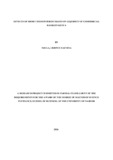| dc.description.abstract | The role of Banks remain central in financing economic activity and its effectiveness could exert
positive impact on overall economy as a sound and profitable Banking sector is better able
to withstand negative shocks and contribute to the stability of the financial system. Banks play
intermediary role in the economy through channeling financial resources from surplus economic
units to deficit economic units. In turn, they facilitate the saving and capital formation in
the economy. Liquidity is the ability of bank to fund increases in assets and meet obligations as
they come due, without incurring unacceptable losses. Hence, liquidity risk arises from the
fundamental role of banks in the maturity transformation of short -term deposits into longterm
loans. Objective of the Study was to examine the effects of short term interest rates on
liquidity of commercial banks in Kenya. The theories used in this study included: Liquidity
Preference Theory, The Real Theory (Model) of Interest Rate and Fisher’s Theory of Interest.
The current study employed the use of both descriptive survey and historical research designs.
The target population for this study was all the 44 listed commercial banks in Kenya as at
December 2015. The study employed the use of document analysis of secondary data. The study
extracted reports on various variables for the last five financial years (2011 to 2015). Secondary
data on the short term interest rates data was collected from financial institutions through their
quarterly reports and CBK and this was the individual weighted lending rates in proportion to the
market share of the firms. The data on Debt to Equity ratio was collected from the firm’s
quarterly financial reports and emphasis put on total liabilities and total assets. The operating
expense ratio was similarly collected from the firms quarterly financial reports of the firms
specifically the operating expenses and the revenue. Secondary data on bank liquidity was
collected from banks basically through quarterly reports on cash and cash equivalents balances
and the value of the total assets. The data collected was sorted, organized and captured in SPSS
analysis tool. The study used one way ANOVA to test the level of significant of the independent
variables on the dependent variable at 95% level of significance, the one way ANOVA was used
to test whether there exist any significant difference between the study variable. In addition, the
study conducted a multiple regression analysis. Inferential statistics was analyzed using
regression analysis to establish the relationship among study variables and to test the
hypothesized relationships. Inferential statistics was carried out using multiple regression
models. The regression model was used to test the strength of the predictor variables. The study
found a weak positive correlation between banks liquidity of commercial banks and short term
interest rates. The study also found weak positive correlation between banks liquidity of
commercial banks and debt to equity ratio. A negative correlation between banks liquidity of
commercial banks and Operating Expense / Revenue was established. The study therefore
concludes that short term interest rates, debt to equity ratio and Operating Expense / Revenue are
not major determinants of bank liquidity in Kenya. Based on the findings on average,
commercial banks in Kenya will register liquidity of negative - 0.422 units if the independent
variables were excluded in the estimation model. This implies there are other control variables
that affect liquidity of banks which were not considered in the study. | en_US |



